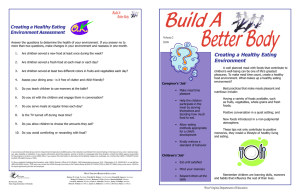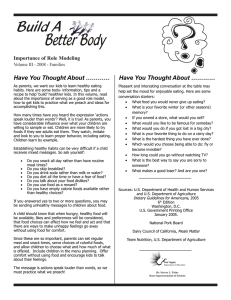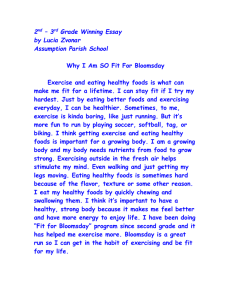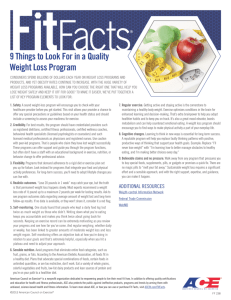Better Body Build A Creating a Healthy Eating Environment
advertisement
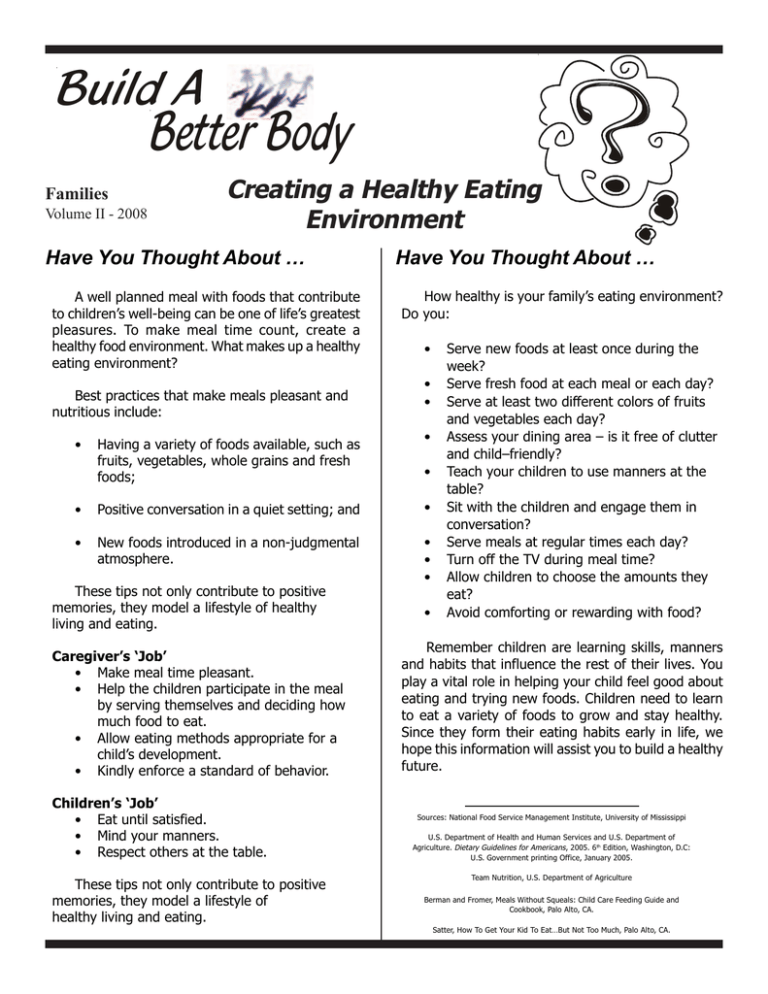
Build A Better Body Families Volume II - 2008 Creating a Healthy Eating Environment Have You Thought About … A well planned meal with foods that contribute to children’s well-being can be one of life’s greatest pleasures. To make meal time count, create a healthy food environment. What makes up a healthy eating environment? Best practices that make meals pleasant and nutritious include: • Having a variety of foods available, such as fruits, vegetables, whole grains and fresh foods; Have You Thought About … How healthy is your family’s eating environment? Do you: • • • • • • Positive conversation in a quiet setting; and • • New foods introduced in a non-judgmental atmosphere. • • • These tips not only contribute to positive memories, they model a lifestyle of healthy living and eating. Caregiver’s ‘Job’ • Make meal time pleasant. • Help the children participate in the meal by serving themselves and deciding how much food to eat. • Allow eating methods appropriate for a child’s development. • Kindly enforce a standard of behavior. Children’s ‘Job’ • Eat until satisfied. • Mind your manners. • Respect others at the table. These tips not only contribute to positive memories, they model a lifestyle of healthy living and eating. • Serve new foods at least once during the week? Serve fresh food at each meal or each day? Serve at least two different colors of fruits and vegetables each day? Assess your dining area – is it free of clutter and child–friendly? Teach your children to use manners at the table? Sit with the children and engage them in conversation? Serve meals at regular times each day? Turn off the TV during meal time? Allow children to choose the amounts they eat? Avoid comforting or rewarding with food? Remember children are learning skills, manners and habits that influence the rest of their lives. You play a vital role in helping your child feel good about eating and trying new foods. Children need to learn to eat a variety of foods to grow and stay healthy. Since they form their eating habits early in life, we hope this information will assist you to build a healthy future. Sources: National Food Service Management Institute, University of Mississippi U.S. Department of Health and Human Services and U.S. Department of Agriculture. Dietary Guidelines for Americans, 2005. 6th Edition, Washington, D.C: U.S. Government printing Office, January 2005. Team Nutrition, U.S. Department of Agriculture Berman and Fromer, Meals Without Squeals: Child Care Feeding Guide and Cookbook, Palo Alto, CA. Satter, How To Get Your Kid To Eat…But Not Too Much, Palo Alto, CA. TIPS Build A Better Body A healthy dinner table is where: All food is ready and at the appropriate temperature. Variety: Including dark green, orange and yellow vegetables is important because they are sources for phytochemicals, biologically active compounds in plant foods believed to offer resistance to diseases. When children are exposed to healthy foods early, they are more likely to develop habits that support healthy weight as they grow. Pleasant environment: Avoid forcing children to eat. Provide wholesome choices and allow them to decide which food and how much. Everyone sits down together. Make your table a welcoming, clean, clutter-free, child friendly place where good manners are practiced. The table is set properly with child appropriate utensils and napkins. Everyone is polite, shares in conversation and uses manners. Let children explore and enjoy foods. They may be messy. Children should be able to touch, smell and taste new foods without feeling pressured to clean their plates. Nonjudgmental atmosphere: Set meal time, choose the foods offered and assure an inviting place to eat. Encourage eating slowly, with enjoyment. Allow children to stop when they are full; no clean plate club members! The wise caregiver offers comfort, not necessarily food, when children cry or fuss. Feeding with love produces better habits than feeding in an emotionally negative climate. NUTRITION TOOL! Sweet Potatoes and Apples Ingredients: 2 cups sweet potatoes 2 cups apples, chopped finely 1/2 cup brown sugar 1 teaspoon cinnamon 1/2 cup oats Method: Mix all ingredients except oats together and place in a casserole dish. Sprinkle oats on top. Bake at 350 degrees for 30-40 minutes or until apples are tender. In accordance with federal law and U.S. Department of Agriculture (USDA) policy, this institution is prohibited from discriminating on the basis of race, color, national origin, sex, age, disability or retaliation. If you require information about this program, activity or facility in a language other than English, contact the USDA agency responsible for the program or activity, or any USDA office. If you require this information in alternative format (Braille, large print, audiotape, etc.) contact the USDA’s TARGET Center at (202) 720-2600 (Voice or TDD). To file a complaint of alleging discrimination, write: USDA, Director, Office of Civil Rights; 1400 Independence Avenue, S.W., Washington, D.C. 20250-9410, or call toll free (866) 632-9992 (Voice). TDD users can contact the USDA through local relay or the Federal Relay at (800) 877-8339 (TDD) or (866) 377-8642 (relay voice users). USDA is an equal opportunity provider and employer.
